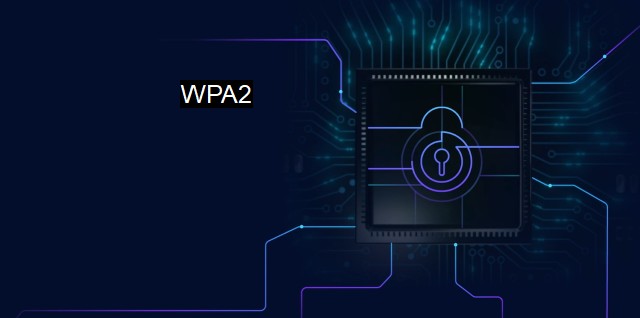What is WPA2?
WPA2: Strengthening Wireless Networks in the Digital Era Against Cyber Threats
WPA2, which stands for Wi-Fi Protected Access II, is a widely adopted security protocol for wireless networks that works to keep connections private. Amid rapidly growing cybersecurity threats, WPA2 comes in as a crucial part of managing and maintaining robust network security.Understanding WPA2 necessitates a brief look into its origins. The early 2000's saw the increase in usage of Wi-Fi, turning it into an essential amenity, akin to utilities like electricity and water. early wireless networks were notoriously insecure, using a protocol called WEP or Wired Equivalent Privacy. WEP's flaws emanated from weak encryption techniques that could be cracked within minutes, even by someone with rudimentary hacking skills.
In response to the vulnerabilities of WEP, the Wi-Fi Alliance, a global network of companies that ensures the interoperability of Wi-Fi technology, launched WPA (Wi-Fi Protected Access). WPA was only a stopgap measure that had been rapidly implemented before the release of the next generation of Wi-Fi security protocols.
Hence, WPA2 was introduced in 2004. Building on the patches and improvements of its predecessor, WPA2 offered a practical and rigorous solution to many of the security issues haunting wireless networks. One of its primary advantages was using The Advanced Encryption Standard (AES), a cryptographic cipher chosen by the U.S. government to protect classified information.
WPA2 practically claims several security aspects. Firstly, it ensures data integrity i.e. the data sent across the network is not tampered with during transit. Secondly, it promotes authentication; devices looking to connect to a WPA2-secured network must provide the correct passphrase. This encryption also reinforces privacy over the Wi-Fi network, so cybercriminals cannot interpret the data being transmitted even if they can intercept it.
For several years, WPA2 had been considered the industry-standard. in October 2017, a serious vulnerability called KRACK (Key Reinstallation Attack) was discovered. The KRACK exploits allow attackers within range of a victim's Wi-Fi network to potentially decode Wi-Fi traffic, inject malicious packets into the data stream they're intercepting, and even hijack the connection.
Despite the subsequent patches released to fix this issue, KRACK emphasized the need for a new wireless network protocol with greater security than what WPA2 could offer and which led to the development and implementation of WPA3.
Cryptocurrency miners, ransomware writers and developers of other malicious programs carry out only part of their attacks through the network. Therefore, a competent antivirus that can provide comprehensive protection against malware, detect phishing sites, and ensure secure online transactions is an integral part of cybersecurity, with or without a robust wireless security protocol in place.
While WPA2 and antivirus software function in different areas of cybersecurity, their roles intersect in the grand scheme. A threat closing in on one aspect of network security makes the entire network vulnerable. This underlines the significance of having a holistic approach to network security. A reliable WPA2 enabled wireless network and powerful antivirus software form a formidable team in protecting data and network integrity by keeping cyber threats at bay.
WPA2 performs a precise function in protecting data transmission over wireless networks, but like many technology-based services, constant updates, patches and subsequent evolved versions are required to maintain that initial level of security. It forms a critical part of the multi-layered security required for today's digital world. In conjunction with effectual antivirus and continued user vigilance towards cyber hygiene, it's an important step towards safeguard internet usage in this data-oriented age.

WPA2 FAQs
What is WPA2?
WPA2 (Wi-Fi Protected Access II) is a security protocol used to secure wireless networks. It is a successor to WPA and uses stronger encryption and authentication methods to protect the network from cyber threats.How does WPA2 work?
WPA2 works by encrypting the data being transmitted over the wireless network using the Advanced Encryption Standard (AES) encryption algorithm. It also uses a four-way handshake process to authenticate devices connecting to the network and prevent unauthorized access.Is WPA2 secure?
Yes, WPA2 is considered a secure protocol for wireless networks. However, like all security protocols, it is not completely infallible and can be vulnerable to attacks if not configured properly or if weak passwords are used.Can antivirus software protect against WPA2 vulnerabilities?
Antivirus software is designed to protect against malware and other cyber threats, but it cannot directly protect against WPA2 vulnerabilities. To protect against WPA2 vulnerabilities, it is important to keep the protocol updated and properly configured, use strong and unique passwords, and implement additional security measures such as firewall protection and intrusion detection systems.Related Topics
Wi-Fi security network encryption password protection router security intrusion detection
| | A | | | B | | | C | | | D | | | E | | | F | | | G | | | H | | | I | | | J | | | K | | | L | | | M | |
| | N | | | O | | | P | | | Q | | | R | | | S | | | T | | | U | | | V | | | W | | | X | | | Y | | | Z | |
| | 1 | | | 2 | | | 3 | | | 4 | | | 7 | | | 8 | | |||||||